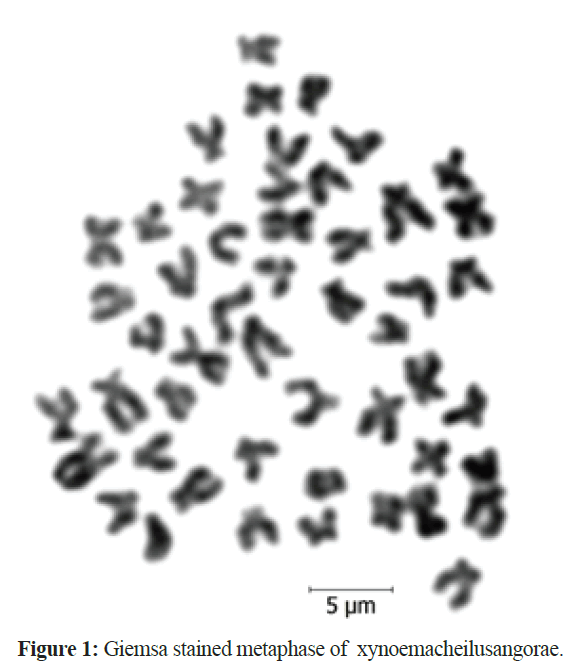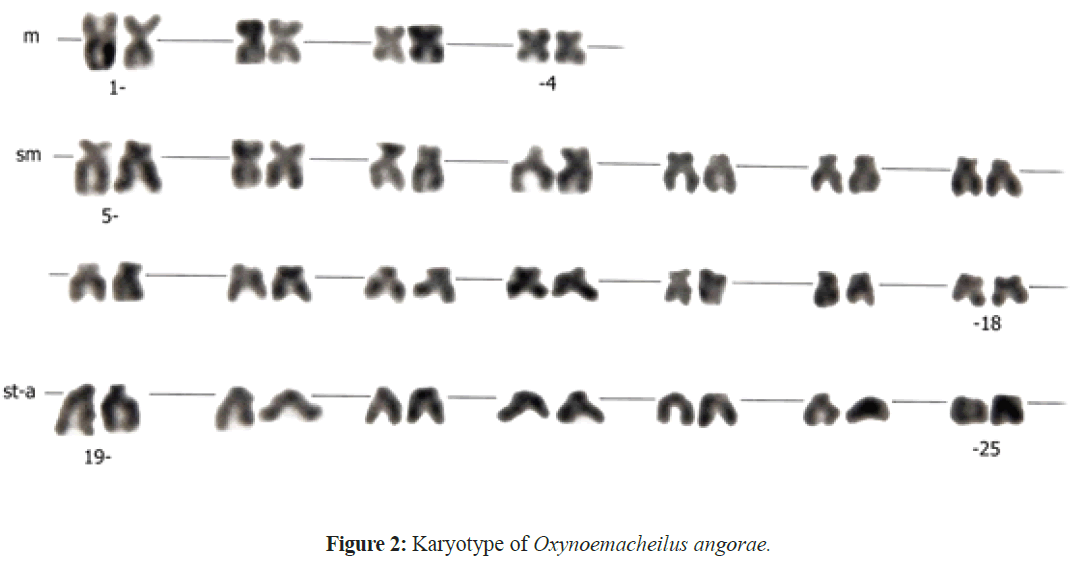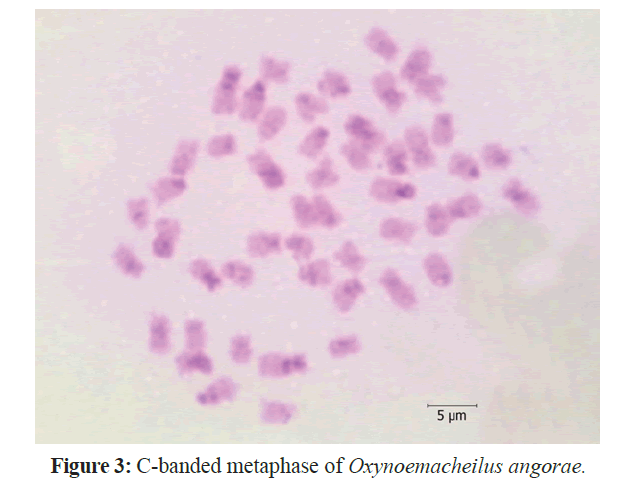Muhammet Gaffaroglu1, Sevgi Unal2, Muradiye Karasu Ayata1*
1Department of Biology, Faculty of Arts and Sciences, Ahi Evran University, 40100 Kirsehir, Turkey
2Department of Biology, Faculty of Science, Gazi University, 06100 Ankara, Turkey
*Corresponding Author:
Muradiye Karasu Ayata
Department of Biology, Faculty of Arts and Sciences
Ahi Evran University, 40100 Kirsehir, Turkey
Tel: +90 386 280 4530
Fax: +90 386 280 4525
E-mail: mkarasu@ahievran.edu.tr
Received date: 16.07.2014 Accepted date: 02.11.2014 Published date: 10.11.2014
Keywords
Nemacheilidae; Oxynoemacheilus angorae; chromosome; constitutive heterochromatin
Introduction
It was reported that Oxynoemacheilus is a species-rich genus (a total of 41 species) of nemacheilid fishes known from Albania east-wards to Central Iran (Freyhof et al., 2011). The systematics of Anatoliannemacheilids is very complex. O. angorae that chromosomal proper-ties were investigated in this study has been re-ported as Nemacheilus angorae Steindachner, 1897 in Cobitidae family by Geldiay and Balik(1988). Also, it was reported that this species is distributed in the whole of Anatolia except for a small portion of Eastern and South-eastern Anatolia. Kuru (2004) was recorded as Orthrias angorae angorae (Steindachner, 1897) in the same family. Otherwise, Fricke et al. (2007) was reported as N. angorae Steindachner, 1897 in Balitoridae family and Freyhof et al. (2011) as Oxynoemacheilus angorae (Steindachner, 1897) in Nemacheilidae family.
Numerous cytogenetic studies have been carried out in fish species which maintained by ichthyologists and geneticists. These studies have been contributed fish taxonomy (Rab et al., 2007). Although chromosomal studies have been reported in some species of Nemacheilidae family (Deger, 2011) there is no report about Kizilirmak population of O. angorae from Turkey.
The aim of this study is to reveal diploid chromosome number, chromosome morphology and C-banding properties of O. angorae from Kizilirmak, Turkey.
Materials and Methods
Seven samples (six female, one male) of O. angorae were collected from Kesikköprü, Kirsehir, Turkey (38° 57' N, 34° 11' E). Meta-phase slides were prepared according to Collares- Pereira (1992)’s “Air Drying Technique”. Also, Sumner (1972)’s C-banding technique was applied to slides. Preparations were scanned in Leica DM3000 microscope and pho-tographs were taken from good metaphases. Chromosomes were classified according to Levan et al. (1964).
Results and Discussion
As a result of this study diploid chromosome number of O. angorae was 2n=50 and karyotype was arranged four pairs of metacentric, 14 pairs of submetacentric and seven pairs of subtelo- acrocentric chromosomes (Figure 1,2). NF was found as 86. Constitutive heterochromatin regions were observed on the centromeres of several chromosomes. Furthermore, two heterochromatin blocks were determined at least on two chromosome pairs and large heterochroma-tin bloc was observed at least on two chromosome pairs (Figure 3).

Figure 1: Giemsa stained metaphase of xynoemacheilusangorae.

Figure 2: Karyotype of Oxynoemacheilus angorae.

Figure 3: C-banded metaphase of Oxynoemacheilus angorae.
It can be said that number of diploid chromosomes are preserved among Oxynoemacheilus species that are distributed in Anatolia but their chromosome morphologies vary (Table 1). While O. angorae has the same number of diploids with O. argyrogramma, O. frenatus and Oxynoemacheilus sp. (Deger, 2011) there are differences between their chromosome morphologies and NF. O. angorae is similar to mostly O. frenatus in terms of chromosome morphology. On the other hand, while the diploid chromosome numbers of Turcinoemachei-lus kosswigi (Deger, 2011; Gaffaroglu et al., 2012) and O. angorae from the same family are similar, their chromosome morphologies are different.

Table 1: Chromosomal studies on some species of Nemacheilidae family from Anatolia.
O. angorae has also similar number of chromosomes with some species of Nemacheilus genus (Arai, 2011). Also O. angorae has similar diploid chromosome number with Noemacheilus barbatulus which belongs to same family (Boron, 1995). The metacentric chromo-some numbers of two species are similar. How-ever while the numbers of sub metacentric chromosome pairs are more than N. barbatulus, the numbers of subteloacrocentric chromosome pairs are less. Accordingly the NF of O. angorae is higher.
In O. angorae sex chromosomes were not coincided as reported in other Oxynoemacheilus species (Deger, 2011).
One of the bandings applied to the fish chromosomes is C-banding. Thanks to this banding, the constitutive heterochromatin regions can be determined in the chromosomes. These regions are mostly found in centromere and telomere of chromosomes. Moreover these regions can be observed through the chromosome arms (Gaffaroglu and Yüksel, 2009).
In terms of C-bands being located in the centromere of many chromosomes, O. an-gorae shows similarity with O. argyrogramma, O. frenatus and Oxynoemacheilus sp. (Deger, 2011). It was observed that C-bands which were reported in centromere of many chromosomes of T. kosswigi (Gaf-faroglu et al., 2012) were more intensive in O. angorae. O. angorae is similar to N. barbatulus in terms of C-bands which were reported in centromere of many chromosomes (Boron, 1995). Besides the heterochromatic regions observed as blocks in some chromosomes of N. barbatulus (Bo-ron, 1995) and T. kosswigi (Gaffaroglu et al., 2012) were also observed in this study. The existence of heterochromatin blocks observed in some chromosomes suggested that some intrachromosomal rearrangements such as pericentric inversion or centric fusion took place (Boron, 1995).
Conclusions
This study is considered to contribute to cytogenetic and cytotaxonomy of Nemacheilidae family.
8748
References
- nBoron, A. (1995). Chromosome banding studies of Noemacheilus barbatulus (Linnaeus, 1758) from Poland, Caryologia, 48, 239-246
- nCollares-Pereira, M.J. (1992). In vivo direct chromosome preparation (Air Drying Technique). 1st Int. Workshop on Fish Cytogenetic Techniques, Concarneau-France, 14-24 September
- nDeger, D. (2011). Dicle ve Firat Su Sistemlerinde Yasayan Bazi Cobitoidea Türleri Üzerine Karyolojik Arastirmalar. Doktora Tezi, Dicle Üniversitesi Fen Bilimleri Enstitüsü, Diyarbakir
- nFreyhof, J., Erk’akan, F., Özeren, C., Perdices, A.(2011). An overview of the western Palaearctic loach genus Oxynoemacheilus (Teleostei: Nemacheilidae), Ichthyological Exploration of Freshwaters, 22, 301-312
- nFricke, R., Bilecenoglu, M., Sari, H.M. (2007).Annotated Checklist of Fish and Lamprey Species (Gnathostoma and Petromyzonto-morphi) of Turkey, Including a Red List of Threatened and Declining Species, Stuttgarter Beitr. Naturk, Sea A, 706,1-172
- nGaffaroglu, M., Karasu, M., Unal, S. (2012). Karyotype of River Loach Turci-noemacheilus kosswigi Banarescu and Nalbant, 1964 (Cypriniformes, Balitoridae) from the Euphrates River, Turkey, Journal of Agricultural Science and Technology, 14, 821-826
- nGaffaroglu, M., Yüksel, E. (2009). Constitutive heterochromatin in Acanthobrama marmid and Cyprinion macrostomus (Osteichthyes, Cyprinidae), Kafkas Üniversitesi Veteriner Fakültesi Dergisi, 15, 169-72
- nGeldiay, R., Balik, S. (1988). Türkiye Tatlisu Baliklari. Ege Üniversitesi Basimevi, Bor-nova, Izmir
- nKaya, T.Ö., Gül, S., Nur, G. (2005). Karyotype Analysis in Orthrias angorae(Steindachner, 1897), Kafkas Universitesi Veteriner Fakültesi Dergisi, 11, 137-140
- nKuru, M. (2004). Türkiye içsu baliklarinin son sistematik durumu, Gazi Üniversitesi Gazi Egitim Fakültesi Dergisi, 24, 1-21
- nLevan, A., Fredga, K., Sandberg, A.A. (1964). Nomenclature for centromeric position on chromosome, Hereditas, 52,201-20
- nSumner, A.T. (1972). A simple technique for demonstrating centromeric heterochromatin, Experimental Cell Research, 75, 304-6.










